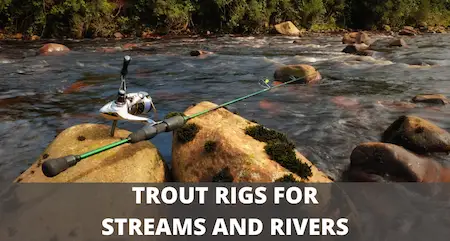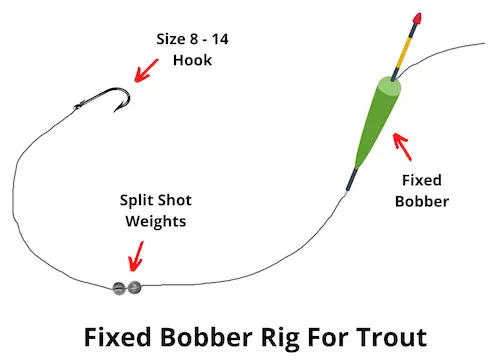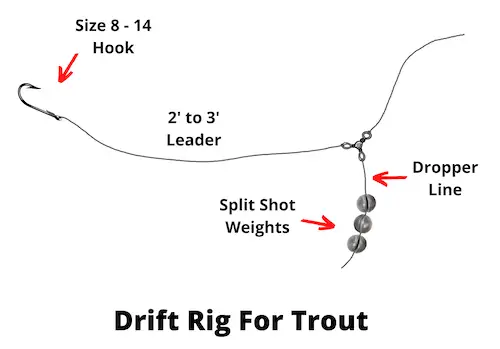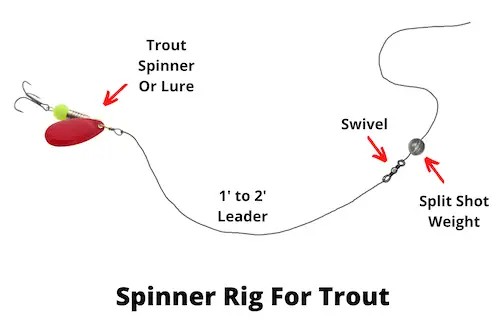UPDATED 03 NOVEMBER 2024
by Robert Ceran
Fishing for trout in streams and rivers is very different from trout fishing in lakes and ponds.
First of all, the trout don’t move around very much, so you need to keep moving yourself, and secondly, all of your fishing tactics need to be effective for fishing in water that’s constantly moving.
In order to catch trout successfully in rivers and streams, it’s important to use the right tactics to find trout positioned in feeding lanes close to the main current, and present your bait to them at exactly the right depth.

In this article we’ll discuss the top 3 trout rigs for rivers and streams, and will go over what each of them is best suited for.
Table of Contents
How do you rig for trout in a stream or river?
The three most important trout rigs for fishing in rivers and streams are:
- Fixed bobber rig
- Drift rig for trout
- Spinner rig
These three trout rigs cover the majority of all trout fishing applications in rivers and streams, and if you know how to use them effectively, you’ll catch a lot of fish.
That being said, each of them comes in several different shapes and sizes, so there is plenty of room to adapt them to your specific fishing conditions.
Both the fixed bobber rig and the drift rig are great tools for drifting a baited hook with the current, and are ideal for presenting it at the right depth for trout in feeding lanes of rivers and streams.
Each of them comes with its own strengths and weaknesses, and we’ll go into those in more detail below.
The spinner rig is a great option for fishing trout lures in any kind of moving water, from tiny streams to wide rivers, and can be adjusted for each of these scenarios.
Now let’s dive into the details, and discuss each of these rigs more fully.
Fixed bobber rig

This is one of the simplest trout rigs, but works very well for streams and rivers, as it allows you to drift your bait with the current into the most promising spots where trout are likely to be positioned while they wait for the current to bring them food.
Since streams are rarely deeper than 6 or 7 feet, you can cover all depths with a fixed bobber rig, and don’t need to use a slip bobber.
One advantage of using a fixed bobber rig is that you can easily adjust the depth at which you’re fishing by sliding your bobber up or down, and thus fish a range of different depths in every spot, before moving on to the next.
Tying a fixed bobber rig is very easy. You start by threading your bobber onto the line, and then tying the line to swivel or snap swivel.
Next tie a 3 to 4 foot fluorocarbon leader to the swivel, and then tie a size 8 to 14 bait hook to the other end of the leader. And finally, add one or more split shots to the rig to weigh down your baited hook in the water.
The best baits to use with this rig are worms, salmon eggs, or plastic beads (which look like salmon eggs).
You can also use plastic worms, which come in a wide variety of colors. Powerbait doesn’t work as effectively for wild trout in streams as it does for stocked trout in lakes.
Drift rig for trout

This is the most important rig for drift fishing for trout in strong currents, and in deep runs and holes.
The advantage of this bottom fishing rig is that it presents your bait close to the bottom, where trout are usually positioned while they wait for the current to carry food to them.
The great thing about the trout drift rig is that you can use a weaker dropper line to attach the split shot weights, and if the weights should get snagged on the bottom, you can break off the dropper line without losing the rest of your setup.
Another advantage is that you can easily adjust the amount of weight by adding or subtracting split shot weights, or switching out a pencil weight at the end of the dropper line.
This is very important, as you’re going to encounter currents of different strengths, and will need different amounts of weight to get your rig down to the bottom fast enough.
In order to tie the drift rig for trout, start by tying your main line to one eye of a three way swivel.
Next, tie a 3 to 4 foot long fluorocarbon leader to another eye of the swivel, and then tie your bait hook to the other end of that leader.
Finally, tie a 2 to 3 inch long dropper line to the third eye of the 3 way swivel, and either attach several split shot weights, or tie a pencil weight to the end of the dropper line.
The best baits to use for trout when drift fishing with this rig are worms and salmon eggs, or plastic beads or plastic worms of various shapes and color.
Incidentally, this setup also works very well for catching steelhead from the bank, and you may be able to target both species at the same time in some rivers.
Spinner rig

This is a classical trout fishing rig that works well in both running and still waters.
When using it in small streams, try to downsize your lures, since the average size of trout is likely to be smaller than in lakes and ponds.
If you’re fishing in bigger rivers, on the other hand, you can definitely upsize your lure size, and will likely be catching bigger fish as well.
While you can potentially tie your main line directly to your lure, it’s better not to do this.
For one thing, you should use a swivel to avoid the lure twisting up your main line, and secondly, if you’re using braided main line, using a fluorocarbon leader will help to avoid spooking fish.
The best way to tie a spinner rig is to start by tying your main line to a size 6 swivel, and then tying 2 to 3 foot of fluorocarbon leader to the other eye of the swivel.
Then tie a bait hook to the leader, and attach one or more split shot weights above the swivel.
The split shot weights are necessary if you’re spinner fishing for trout in a strong current, and need to get your trout spinner or lure down to the right depth as fast as possible.
What is the best rig for trout fishing in streams?
The best rig for trout fishing in streams is the fixed bobber rig. It’s the perfect setup for drifting a baited hook or soft plastic worm along trout feeding lanes in streams.
The correct way to fish a bobber rig is to lift your main line up above the water, which results in the whole setup floating down the stream at a natural speed with the current, and this is by far the best tactic to catch trout in streams.
That being said, you can definitely also use the other two rigs to your advantage when fishing in trout streams.
The drift rig is a great option if you’re fishing in strong currents, and the spinner rig is ideal if you want to cover a lot of water quickly.
What is the best rig for trout fishing in rivers?
The best rig for trout fishing in rivers is the drift rig, since it’s ideal for presenting your bait close to the bottom even in strong currents.
By adjusting the amount of weight on the rig you can easily switch from one strength of current to another.
And since this fishing rig is also great for catching steelhead in rivers, it’s definitely worth learning how to use it effectively.
Best rod and reel setup for trout fishing in streams and rivers
Now let’s talk about the best trout rod and reel setup to use when fishing with these rigs.
All three rigs are best fished with a 7 to 8 foot long light or ultralight spinning rod.
However, when fishing on small streams, you may want to choose a shorter rod around 6 foot long, since that’s easier to use under trees and bushes.
Also, if you’re fishing in big rivers where trout grow larger (or where you could hook into steelhead as well), you probably want to increase the strength of your rod to medium power.
The ideal reel to use with this setup is a 2000 to 3000 size spinning reel spooled with 10 to 20 lb test braided line.
Braid is the best choice of trout fishing line in rivers because it has almost no stretch, which allows you to feel trout bites with more sensitivity compared to mono or fluoro.
While braid is the best choice for your main line, the leader should definitely be fluorocarbon, since that has lower visibility underwater, and presents your bait with more stealth.











































